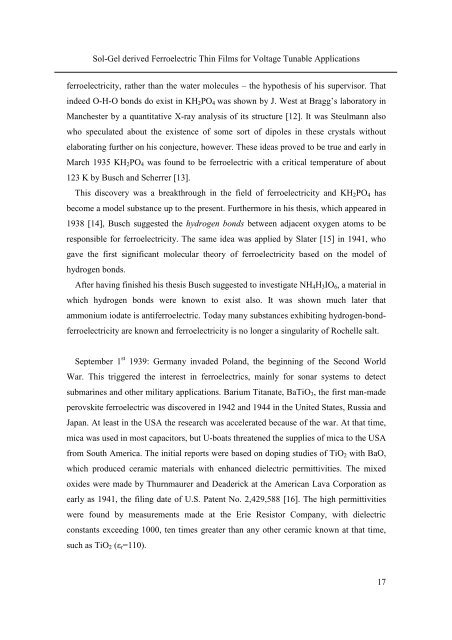PhD Thesis Arne Lüker final version V4 - Cranfield University
PhD Thesis Arne Lüker final version V4 - Cranfield University
PhD Thesis Arne Lüker final version V4 - Cranfield University
You also want an ePaper? Increase the reach of your titles
YUMPU automatically turns print PDFs into web optimized ePapers that Google loves.
Sol-Gel derived Ferroelectric Thin Films for Voltage Tunable Applications<br />
ferroelectricity, rather than the water molecules – the hypothesis of his supervisor. That<br />
indeed O-H-O bonds do exist in KH2PO4 was shown by J. West at Bragg’s laboratory in<br />
Manchester by a quantitative X-ray analysis of its structure [12]. It was Steulmann also<br />
who speculated about the existence of some sort of dipoles in these crystals without<br />
elaborating further on his conjecture, however. These ideas proved to be true and early in<br />
March 1935 KH2PO4 was found to be ferroelectric with a critical temperature of about<br />
123 K by Busch and Scherrer [13].<br />
This discovery was a breakthrough in the field of ferroelectricity and KH2PO4 has<br />
become a model substance up to the present. Furthermore in his thesis, which appeared in<br />
1938 [14], Busch suggested the hydrogen bonds between adjacent oxygen atoms to be<br />
responsible for ferroelectricity. The same idea was applied by Slater [15] in 1941, who<br />
gave the first significant molecular theory of ferroelectricity based on the model of<br />
hydrogen bonds.<br />
After having finished his thesis Busch suggested to investigate NH4H3IO6, a material in<br />
which hydrogen bonds were known to exist also. It was shown much later that<br />
ammonium iodate is antiferroelectric. Today many substances exhibiting hydrogen-bond-<br />
ferroelectricity are known and ferroelectricity is no longer a singularity of Rochelle salt.<br />
September 1 st 1939: Germany invaded Poland, the beginning of the Second World<br />
War. This triggered the interest in ferroelectrics, mainly for sonar systems to detect<br />
submarines and other military applications. Barium Titanate, BaTiO3, the first man-made<br />
perovskite ferroelectric was discovered in 1942 and 1944 in the United States, Russia and<br />
Japan. At least in the USA the research was accelerated because of the war. At that time,<br />
mica was used in most capacitors, but U-boats threatened the supplies of mica to the USA<br />
from South America. The initial reports were based on doping studies of TiO2 with BaO,<br />
which produced ceramic materials with enhanced dielectric permittivities. The mixed<br />
oxides were made by Thurnmaurer and Deaderick at the American Lava Corporation as<br />
early as 1941, the filing date of U.S. Patent No. 2,429,588 [16]. The high permittivities<br />
were found by measurements made at the Erie Resistor Company, with dielectric<br />
constants exceeding 1000, ten times greater than any other ceramic known at that time,<br />
such as TiO2 (εr=110).<br />
17

















